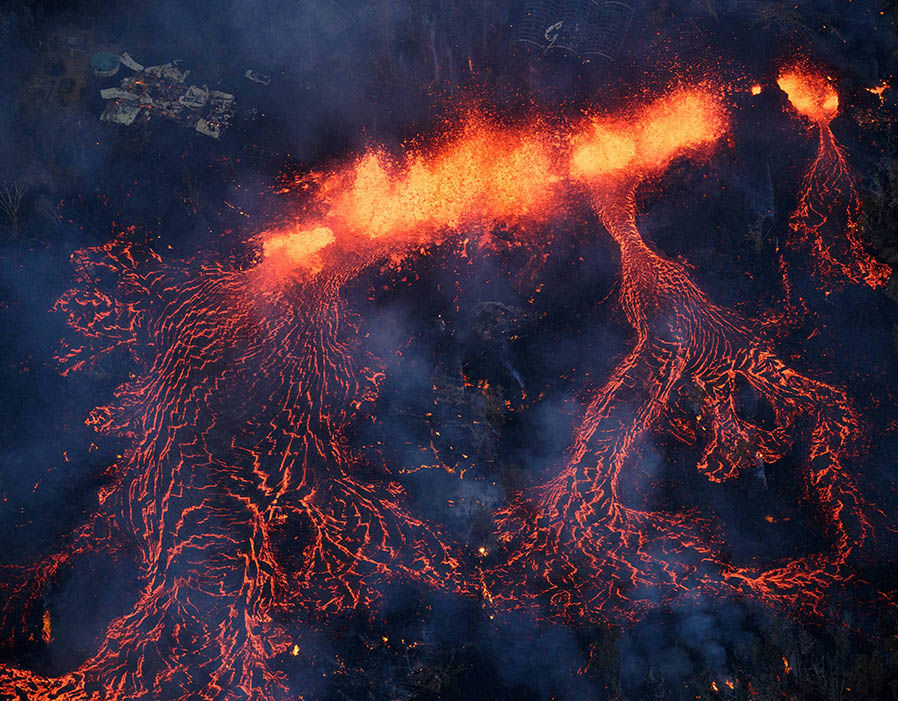
Though it is not uncommon for the Kilauea volcano on the southern shore of Hawaii’s Big Island to erupt, the recent explosion is the worst encountered in decades. The sea of lava, which has been flowing unabated since May 3, has enveloped 104 acres (the equivalent of 100 football fields), destroyed 35 structures — including 26 homes — and forced almost 2,000 people to evacuate. Unfortunately, even experts have no idea when the volcanic activity will subside.
The disaster began on Monday, April 30, when the floor of the Puʻu ʻŌʻō crater at the top of the 4,190-foot-tall (1,227 meters) shield volcano collapsed, sending its magma pool underground and triggering small earthquakes. On May 1, cracks appeared in the volcano, and on May 3, a plume of pink smoke, accompanied by lava, emerged through a gash shooting dozens of feet into the air. The island has continually been rocked by tremors of various intensities since the eruption, including a 6.9 magnitude earthquake on Friday, May 4 — the largest the state has felt in 43 years.

Over a dozen fissures — linear vents which spread out like fingers from a volcano — have emerged since, and are ejecting hot steam and noxious gases and lava fountains as high as 330 feet into the air. Wendy Stovall, a volcanologist with the United States Geological Survey (USGS), warns that things may get worse before they get better. As the fissures continue to spread along the East Rift Zone, Stovall says that some of the vents will harden and close, resulting in lava shooting through the remaining ones with even more intensity, potentially reaching heights of 1,000 feet. Along with finding refuge away from the unstoppable lava’s path, residents also have to watch out for the toxic sulfur dioxide fumes, known to cause respiratory failure, kill plants, and even tarnish car windows.
To make matters worse, on Wednesday, May 9, the USGS warned residents that as the magma sinks further inside the crater, it could interact with the groundwater and create explosive steam eruptions. The "ballistic projectiles” emitted could be as small as pebbles or weigh several tons!

With precipitation in the forecast, there is also concern about acid rain being formed as the water molecules mix with the toxic gas. However, Sasha Madronich, an atmospheric chemist at the National Center for Atmospheric Research, believes the level of acid is not going to be high enough to pose any danger to the residents.
Though the eruptions are among the largest in recent history, Hawaiian officials say the damage is primarily restricted to areas with low or no population. The most impacted areas are the Leilani Estates and Lanipuna Gardens subdivisions, near the eastern town of Pahoa in the Puna district. The area’s residents have been forced to flee to safer grounds as lava oozes through their once serene communities, swallowing trees, cars, roads, and houses.

While scary, volcanic eruptions are almost as ubiquitous to the island’s residents as its stunning beaches and verdant tropics. The slope-sided Kilauea is the world’s longest-erupting volcano and the youngest of five explosive peaks on the Big Island, including Mauna Loa, the world’s largest shield volcano.
Many residents believe that Kilauea’s eruptions are not just natural disasters, but the act of Pele, a Hawaiian volcano goddess who resides inside the mountain. According to legend, when the deity, one of the universe creator’s six daughters and seven sons, was exiled to Hawaii, she went on a rampage, creating destructive fire pits and volcanoes. While Pele was killed during an epic battle with her sister Namaka on the island of Maui, her spirit lives on in the Halemaumau crater on Kilauea.

To appease her, many residents have left offerings of large ti leaves, which are believed to bring good luck, in the cracks in the ground. They are hoping these gifts will make her happy and encourage her to protect their homes. “The way I kind of look at it is, the land doesn’t really belong to us. It belongs to Pele,” said Jordan Sommer, a Leilani Estates resident who was forced to leave her home, with fellow resident Steve Clapper adding: “Pele’s the boss, you know.” Hopefully, the “boss” will calm down soon, allowing the displaced residents to return home and start rebuilding their lives.

Destructive as they may be, volcanic eruptions are natural geological processes that allow our planet to release a build-up of heat and pressure. Unfortunately, this also means Kilauea’s eruptions will continue as long as there is magma that needs to be released — and experts are not sure how long the process will take. “We don’t have a good idea of how big it is and how long it’ll last,” said Tracy Gregg, an associate professor of geology at the University of Buffalo. “It could be a couple of days, a couple of weeks. It could be a couple of months. We just have to wait and see.”
Resources: Vox.com,cnn.com,cnn.com,theverge.com, wikipedia.org
